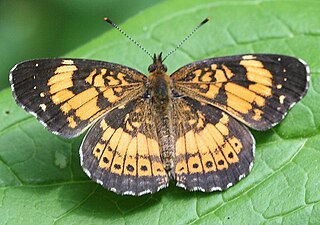
Chlosyne nycteis, the silvery checkerspot, is a species of Nymphalinae butterfly that occurs in North America. It is listed as a species of special concern in Connecticut and Maine, and is believed extirpated in Connecticut, Massachusetts, and New Hampshire.
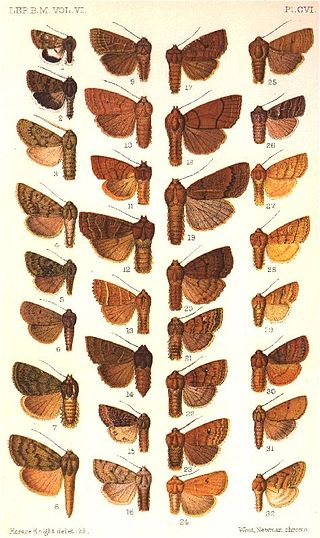
Psectraglaea is a monotypic moth genus of the family Noctuidae described by George Hampson in 1906. Its only species, Psectraglaea carnosa, the pink sallow, described by Augustus Radcliffe Grote in 1877, is native to North America. It is listed as threatened in Connecticut, and as a species of special concern in Massachusetts.
Abagrotis nefascia is a moth of the family Noctuidae first described by Smith in 1908. It is found in North America from Alberta and British Columbia down through Massachusetts to California. The species is listed as threatened in the US state of Connecticut.

Catocala pretiosa, the precious underwing, is a moth of the family Erebidae. The species was first described by Joseph Albert Lintner in 1876. It was included in Catocala crataegi by many authors, but recently it has been revalidated as a distinct species. The subspecies of pretiosa is listed as a species of special concern and believed extirpated in the US state of Connecticut.
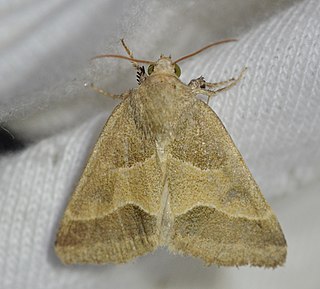
Schinia gracilenta, the slender flower moth or iva flower moth, is a moth of the family Noctuidae. The species was first described by Jacob Hübner in 1818. It is found from the US states of New York to Florida and Nebraska to Arizona. The species is listed as endangered in Connecticut.

Acronicta albarufa, the barrens dagger moth, is a moth of the family Noctuidae. It has a fragmented distribution in North America that includes southern Ontario and Manitoba, New York, New Jersey, Massachusetts, North Carolina, Virginia, Georgia, Oklahoma, Missouri, Arkansas, and Colorado. It may also be present in Ohio, Pennsylvania, Connecticut, mainland New York and New Mexico. It has been suggested that populations in the south-western United States may be a separate species. It is listed as a species of special concern and believed extirpated in the US state of Connecticut.

Acronicta falcula, the corylus dagger moth, is a moth of the family Noctuidae. The species was first described by Augustus Radcliffe Grote in 1877. It is found in the United States and Canada from southern New England to southern Manitoba and Iowa. Recently seen from Wisconsin, Connecticut, Rhode Island, New York and Michigan. It is reported as rare in Ohio. It is listed as a species of special concern in the US state of Connecticut.

Dichagyris acclivis is a moth of the family Noctuidae. It is found from southern Ontario and southern Massachusetts south to eastern Tennessee and western North Carolina, west to Illinois, Missouri, and Kansas and south to east central Texas. It is listed as a species of special concern in Connecticut.
Euxoa pleuritica, the fawn brown dart, is a moth of the family Noctuidae. It is found in southern Canada and the northern United States from southern Quebec and eastern Massachusetts west to British Columbia and southern Washington. In the Rocky Mountain region it occurs as far south as northern New Mexico, north-eastern Arizona and central Idaho. It is listed as a species of special concern in Connecticut.
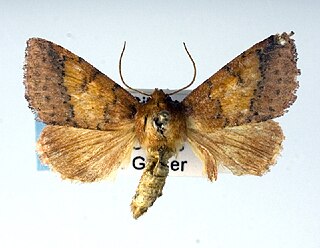
Rhodoecia aurantiago, the orange sallow moth or aureolaria seed borer, is a species of moth of the family Noctuidae. It has a scattered distribution from southern Maine and the hills around Boston, Massachusetts, west across southern Ontario to south-western Wisconsin and Missouri, south into Florida and Texas. It is listed as threatened in the US state of Connecticut.

Erynnis horatius, commonly known as Horace's duskywing, is a species of butterfly in the family Hesperiidae. It is found in the United States from Massachusetts to Florida, and west to eastern South Dakota, the Gulf Coast, south-eastern Utah, Colorado, north-eastern Arizona, and New Mexico. It is listed as a species of special concern in the US state of Connecticut.
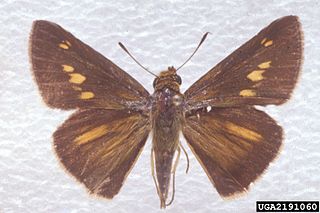
Euphyes dion, the Dion skipper or Alabama skipper, is a species of butterfly of the family Hesperiidae. It is found in scattered populations along the Atlantic coast of North America, from western Massachusetts and south-eastern New York south to north-eastern Florida, west to north-eastern Texas, and north to south-eastern North Dakota, northern Wisconsin, southern Ontario and southern Quebec. It is listed as a species of special concern in the US state of Connecticut.
Thaumatopsis edonis is a moth in the family Crambidae. It was described by Augustus Radcliffe Grote in 1880. It is found in North America, where it has been recorded from Florida, Kentucky, Maine, Massachusetts, Mississippi, Missouri, Nebraska, New Jersey, Oklahoma and South Carolina. It is listed as threatened in the US state of Connecticut.
Speranza exonerata, the barrens itame, is a moth of the family Geometridae described by Douglas C. Ferguson in 2008. It is found in Massachusetts, New Hampshire, Pennsylvania and New Jersey. It is listed as threatened in the US state of Connecticut.

Dargida rubripennis, the pink streak, is a species of moth in the family Noctuidae. It was described by Augustus Radcliffe Grote and Coleman Townsend Robinson in 1870. It is found in the eastern United States, ranging to Kansas and Texas. It is listed as threatened in the US states of Massachusetts and Connecticut. The wingspan is 32–37 mm.

Zanclognatha theralis, the noctuid moth, is a species of moth native to North America. It was described by Francis Walker in 1859. It is listed as threatened in the US state of Connecticut.

Pyreferra ceromatica, the anointed sallow moth, is a species of moth native to North America. In the US state of Connecticut it is listed as a species of special concern and is believed to be extirpated. It was described by Augustus Radcliffe Grote in 1874.
Sympistis perscripta, the scribbled sallow moth is a moth of the family Noctuidae that is native to North America. It is listed as a species of special concern in the US states of Connecticut and Massachusetts. It was described by Achille Guenée in 1852. The larval hosts are Antirrhinum, Linaria, and Nuttallanthus.
Photedes inops, the spartina borer moth, is a species of moth native to North America. The larvae are hosted on Spartina pectinata, apparently exclusively. It is listed as a species of special concern in the US state of Connecticut.
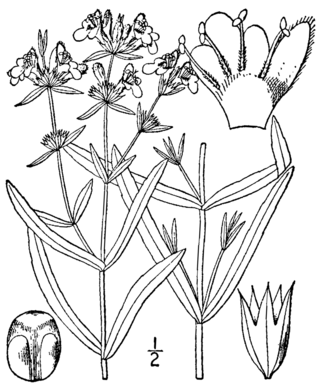
Stachys hyssopifolia, commonly known as hyssop-leaf hedge-nettle, rough hedge-nettlehyssop-leaved hedgenettle, and hyssop hedge-nettle is a species of flowering plant in the mint family (Lamiaceae).












